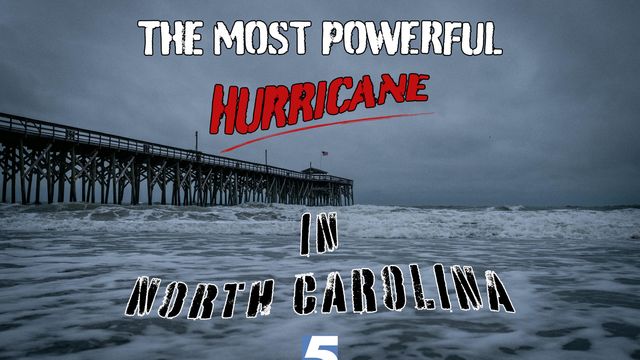The most powerful hurricane in North Carolina: The history and aftermath of the largest hurricane in NC history
What was the most powerful hurricane to hit North Carolina? There have been a handful of powerful tropical storms that have passed through the state, but North Carolinians are resilient and are great at preparing for big storms. Ok, so bread and milk might sometimes be sparse though. So what is the most powerful hurricane in North Carolina history? You might be surprised…
This Hurricane in North Carolina was the most powerful
Hurricane Hazel was the most powerful hurricane to ever hit North Carolina. The storm caused major flooding and damage as it made landfall in October 1954. More than 1,000 people were killed in the storm after it formed off the eastern coast of Grenada and then tore through Haiti, Cuba, The USA, and even Canada. Many other people were left homeless. The storm caused about $409 million in damage, equivalent to more than $4.5 billion today. And a total of 591–1,191 people were killed. The massive amount of destruction left by Hurricane Hazel earned it the nickname “the Bulldozer.”
History of this Hurricane in North Carolina: Hurricane Hazel was a Category 4 storm when it made landfall in North Carolina on October 15, 1954.
Category 4 Hurricane Hazel made landfall on October 15, 1954, near Wilmington, North Carolina. Hazel was a Category 4 hurricane when it struck North Carolina, and its winds were estimated to be 125 mph at Wrightsville Beach and 140 mph at Oak Island. The storm was the most powerful hurricane to hit the state to date. The storm surges averaged about 12 feet but got up to 18 feet at Calabash. Gusting winds as high as 90 mph were recorded at Raleigh-Durham International airport. But in surrounding towns of Kinston, Goldsboro, and Faison, gusts as high as 120 mph were recorded.
Damage from the hurricane was extensive, with $163 million in damage (equivalent to almost $1.8 billion today) in the Carolinas. 95 people were killed in the USA as a result of the storm.
Path: Hurricane Hazel struck multiple countries and left a lasting impact for years to come

Hurricane Hazel’s path started as far southeast as Grenada and that's only after it was discovered about 50 miles off the eastern coast. It then moved west over the Caribbean Sea before rapidly turning north and intensifying into a Category 4 Hurricane and hitting Haiti. The death toll in Haiti was estimated to be between 400-1000 people. Hazel moved north and intensified again as it moved over warmer water. It made landfall at the border of North Carolina and South Carolina and proceeded to head north with 100+ mph winds through North Carolina, Virginia, Maryland, Pennsylvania, Delaware, New Jersey, and New York. It crossed into Canada near Toronto where it caused immense damage in a city that was unprepared. It finally was absorbed into a larger storm over the southern end of Hudson Bay. The death toll in Canada was 81.
Impact: The hurricane caused extensive damage, killing 19 people and injuring more than 100 in North Carolina.

Hurricane Hazel dry-docked boats in backyards
Photo courtesy: Leila Pigott
The hurricane was the most powerful one to ever hit North Carolina and caused extensive damage. The hurricane also caused massive power outages, leaving many people without power or water for extended periods of time. The hurricane also damaged or destroyed many homes and businesses. Many parts of the state were left without power and/or water for weeks.
In addition to 15,000 homes being destroyed in North Carolina, another 39,000 sustained damage to varying degrees. Property in the Carolinas was damaged to the tune of $163 million. According to the national weather service, property damage along the Atlantic coast amounted to $61 million alone. Elsewhere in the eastern United States, the damage was estimated at $145 million, resulting in pre-tax expenses of $308 million.
Recovery: It took years for the state to recover from the impact of Hurricane Hazel.

Since Hurricane Hazel was the most powerful hurricane to ever make landfall in North Carolina, the state took years to recover from the impact of the storm. To prevent looting, the National Guard was mobilized on October 17th, 1954. Two days later President Dwight D. Eisenhower declared a “major disaster” in the Carolinas and offered “immediate and unlimited federal assistance”. A major sandbar was re-created at the coast where Hazel made landfall too.
Lessons Learned: The hurricane in North Carolina taught officials important lessons about preparedness that would help them better cope with future hurricanes.

Officials in North Carolina say they have learned important lessons about preparedness following Hurricane Florence. The Category 4 storm caused significant damage and flooding in the state, and officials say they are now better equipped to deal with a more powerful hurricane.
One of the key takeaways is the importance of having a plan for evacuating residents. Many people were stranded in their homes during Florence due to flooded roads, and officials say they will work to create better evacuation plans for future storms.
They also say it is important to have a stockpile of supplies ready in case of a major storm. This includes food, water, and medicine, as well as materials for repairing the damage. Officials plan to use the lessons learned from Florence to help prepare for future storms that may be more powerful.
Hurricane Hazel was a devastating storm but also helped improve the state's hurricane readiness.
Hurricane Hazel was a devastating storm that helped improve the state's hurricane readiness. North Carolina has since been able to better prepare for future storms, which has saved lives and reduced property damage. Everyone continues to learn from past storms like these and take the necessary precautions to protect citizens and property when future storms hit the state. Are you ready for the big one? You can be prepared for the next big storm right now! Here are some ways you can prepare for the next big hurricane.
Related articles:
- Do you know how hurricanes are named?
- Hurricane season in NC is coming back
- What you need to know about the Saffir-Simpson Wind Scale
- Count down N.C.'s five most destructive hurricanes
- Dating back to the 1750s: Hidden history of NC's earliest hurricanes











